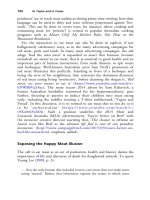The palgrave international handbook of a 240
Bạn đang xem bản rút gọn của tài liệu. Xem và tải ngay bản đầy đủ của tài liệu tại đây (27.31 KB, 1 trang )
International Trade in Animals and Animal Parts
235
outside the offender’s control. This, in turn, helps offenders in the IWT to
condemn the condemners—it is not their behaviour (others can, after all,
engage in these acts legally), but the unreasonable rules and legislators at
fault. Von Essen et al. (2014) recognise poachers’ offences as a form of social
defiance in reaction to disillusionment and distrust of authority, legislation
and processes. Finally, in terms of appealing to higher loyalties, Sollund
(2012) suggests offenders legitimise their actions by claiming the use of
animals serves a higher need. For example, the need to cure serious human
illnesses is central to the demand in traditional medicine; as evidenced by
exponential growth in demand for rhino horn linked to uncorroborated
claims that rhino horn medicine cured cancer (UNODC 2013).
Accordingly, the commonplace harms inflicted on wildlife are an indirect
consequence of trade activities, as offenders use techniques of neutralisation
to routinely permit or ignore this abuse.
Responses to the IWT
Responses to the wildlife trade, while diverse, broadly fall into official
(political mobilisation, legislation, enforcement and prosecution) and unofficial responses (non-governmental prevention and intervention), both are
discussed below with a particular focus on UK data from the EFFACE
project. The official response to abuse in the wildlife trade primarily focuses
on regulating the trade, while the unofficial response engages with both
regulation and animal welfare. What follows is a brief description of the
official and unofficial responses to the wildlife trade. In so doing, we detail
the nature of these responses and consider how effective they are in preventing harm to wildlife.
The Official Response
Maher and Sollund’s (2016) evaluation of the UK and Norwegian responses
to the IWT supports existing literature in identifying shortfalls in the
regulation of the wildlife trade. Fundamentally, animal welfare does not
underpin the official response, resulting in inadequate prevention of harm
to wildlife. Their research found that legislation, policy and the enforcement,
prosecution and sentencing of offences not only fails to adequately consider
animal welfare but also causes further harm through, for example, the
euthanasia of healthy animals. This is not to say animal welfare has not









